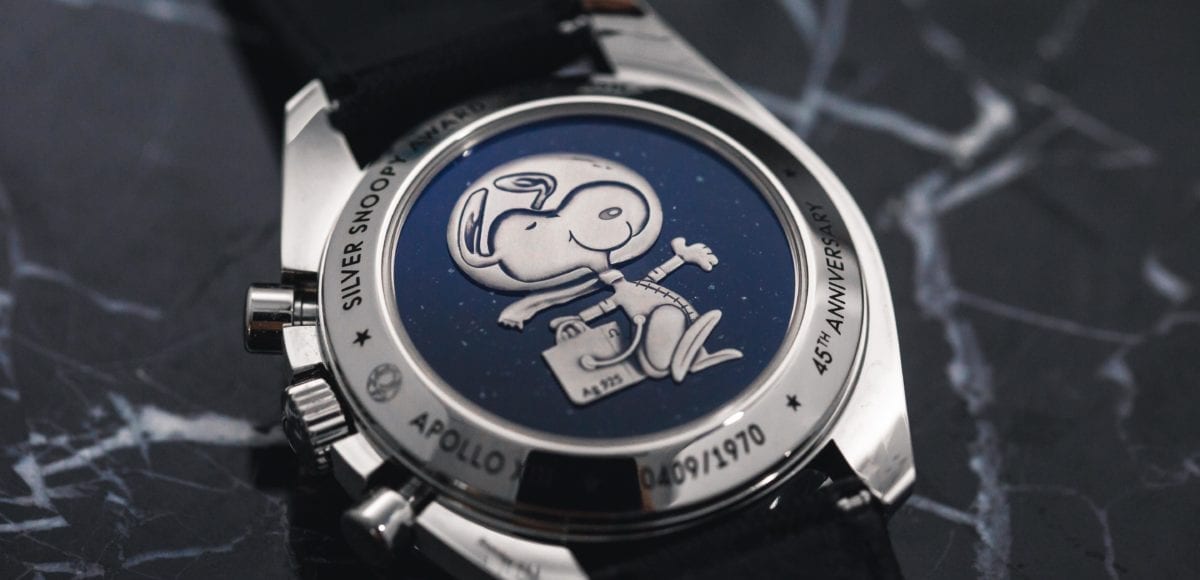OMEGA Watches & Apollo 13
The gripping story of the Apollo 13 mission is not just a historic moment in American space exploration. It’s also an abiding testament to man’s endurance, ingenuity, and courage. During those crucial moments of the Apollo 13 flight, the crew relied on a critical tool: an OMEGA watch. Snoopy and astronauts seem like an unlikely pair, but there is deep history between the comic beagle & Apollo 13. Learn about the OMEGA that saved the mission.
On April 13th, 1970, astronauts James Lovell, John Swigert, and Fred Haise were preparing for a landing on the moon when disaster struck. An oxygen tank on the craft’s exterior exploded, requiring all nonessential systems to be immediately powered down. Urgent repairs had to be made, and the mission was aborted. 205,000 miles from Earth, with supplies of food and water limited and all heating lost, it was vital to get the astronauts back before time ran out. Far from home, faced with a dangerous and rapidly devolving situation, each of them could watch the seconds tick by on the OMEGA Speedmaster Professionals they wore on their wrists.
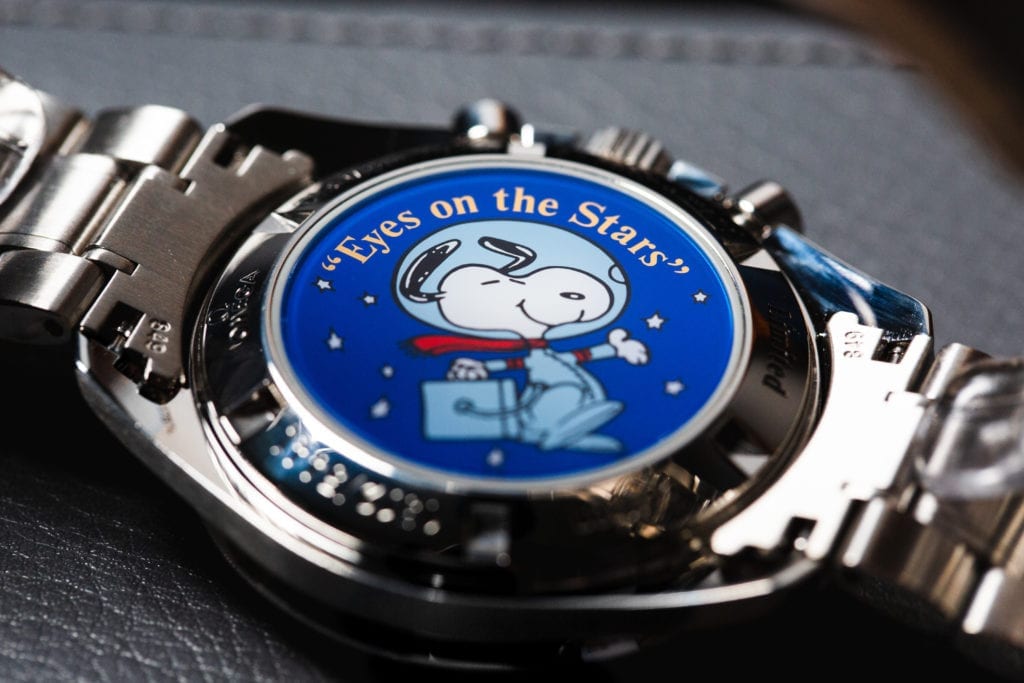
A Successful Launch
OMEGA introduced the Speedmaster in 1957 as a chronograph designed specifically for sport and racing. The 42mm watch has a distinctive black dial and tachymeter bezel, with hands and hour markers coated in Superluminova. However, the Speedmaster quickly departed from its sport and racing roots. In 1964, NASA began the procurement process for an official watch that its astronauts could wear in space. They approached several watch manufacturers, but only the OMEGA Speedmaster lasted through the rigorous testing process. Declared operational for space exploration and officially flight-certified, the OMEGA Speedmaster Professional soon became the first watch on the moon. From then on, it’s garnered the nickname the Moonwatch and traveled on each subsequent Apollo mission. To this day, the Speedmaster is the only piece of equipment to have been used in every NASA piloted mission. In addition, it’s one of the few not manufactured in-house by NASA itself.
THE APOLLO 13 CREW AFTER THEIR SAFE LANDING.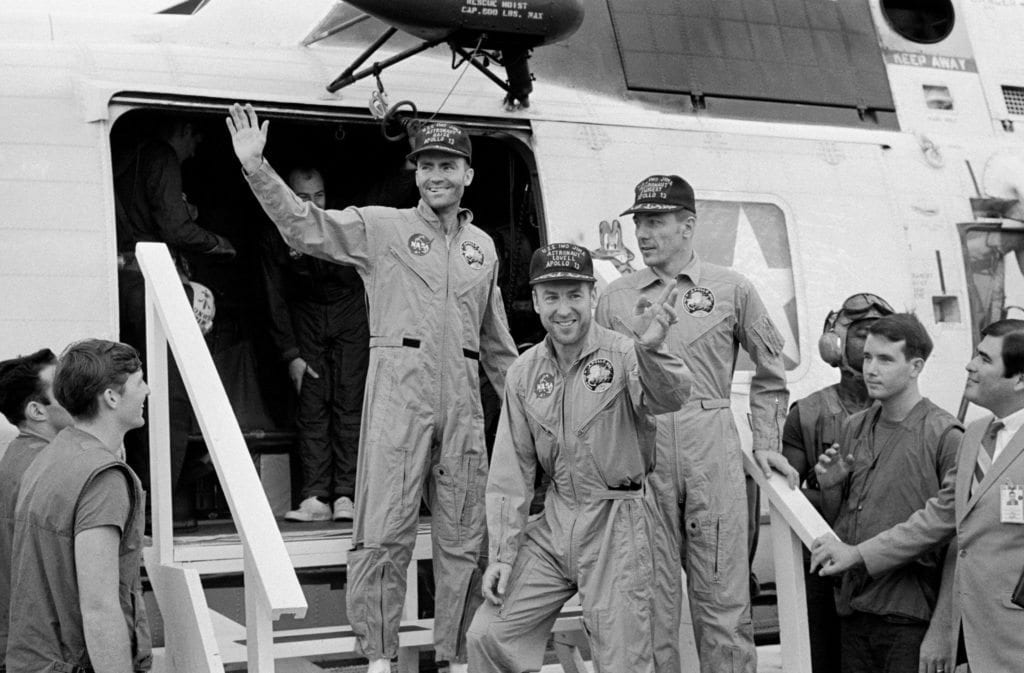
THE APOLLO 13 CREW AFTER THEIR SAFE LANDING.
The Story Behind the Silver Snoopy Award
Of all the Space Flight Awareness Awards, the Silver Snoopy Award is the most prestigious. NASA astronauts present it to fellow NASA employees and contractors for their outstanding contributions to flight safety and successful missions. Each year, less than one percent of the aerospace program workforce receives this award, making it a particularly special honor. This history of the Silver Snoopy Award dates back to 1968. That year, the first-ever award was bestowed to certain members of the crew who worked on the LTA-8 project. They were responsible for testing what would become the first lunar module. Over the past fifty years, tens of thousands of people have received a Silver Snoopy Award. However, there’s one recipient in particular who’s especially near and dear to our hearts: Hans Widmer, OMEGA’s former technical manager.
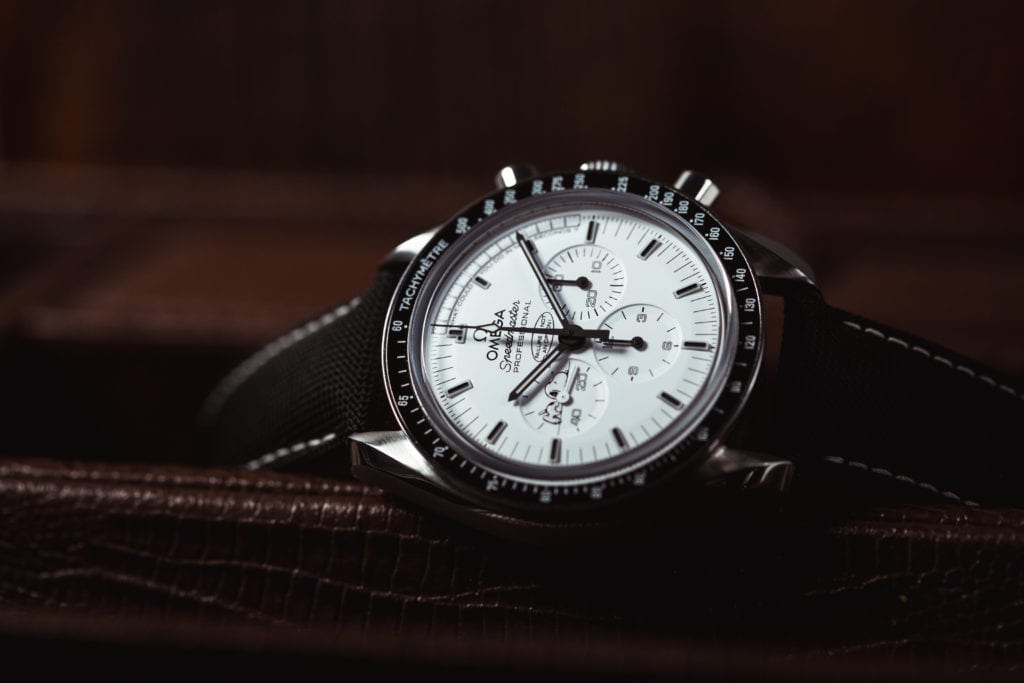
The Apollo 13 Mission
1970 marked a particularly significant moment in OMEGA and NASA’s work together. On April 13th of that year, astronauts James Lovell, John Swigert, and Fred Haise were preparing for another lunar landing. Then, an oxygen tank on the craft’s exterior exploded and all non-essential systems had to power down. The crew had to abort the mission they set out on and pursue another.
“Houston, we’ve had a problem”
Confined to a cramped lunar module designed purely for moon landings and not desperate rescue attempts, suffering from extremely low temperatures, dehydration, and exhaustion, the crew’s time was running out. Their hopes of landing on the moon now dashed, they knew they had only one shot at getting home. After a hurried assessment of the damage caused by the oxygen tank blowout, NASA’s ground control team, led by Flight Director Gene Kranz, decided that the best chance of successfully getting the crew back to Earth would involve using the gravity of the moon along with the lunar module’s Descent Propulsion System (DPS). The problem was, at the current angle of descent, the module would “bounce” straight back into space. At that point, there could be no recovery. Since the lunar module had no automatic guidance system, the astronauts would have to burn the engines for exactly the right amount of time in order to adjust their trajectory and hit the Earth’s atmosphere at the correct angle. In need of total accuracy, Swigert chose to rely on his OMEGA Speedmaster Professional to time the burn. It proved to be the right decision. As the lunar module began its descent, the first burn, lasting 14 seconds, was so precise that they only needed to make two slight adjustments. The craft splashed down safely into the South Pacific on April 17th. Despite the extreme temperature and pressure of reentry, their watches continued to keep perfect time.
Failure Is Not an Option
Six months down the road, on October 5th, astronaut Thomas Stafford presented the Silver Snoopy Award to Hans Widmer. The accolade honored OMEGA’s contribution to the safe return of the Apollo 13 crew. This sterling silver lapel pin features a Spaceman Snoopy drawn by Peanuts creator Charles M. Schulz himself. This small but significant token is one of America’s most prestigious decorations. It represents an appreciation of dedication, professionalism, and outstanding support for the space program. Years later, OMEGA would in turn honor the Apollo 13 mission. They did so with a special edition model showcasing Kranz powerful words to the crew, “Failure is not an option.”
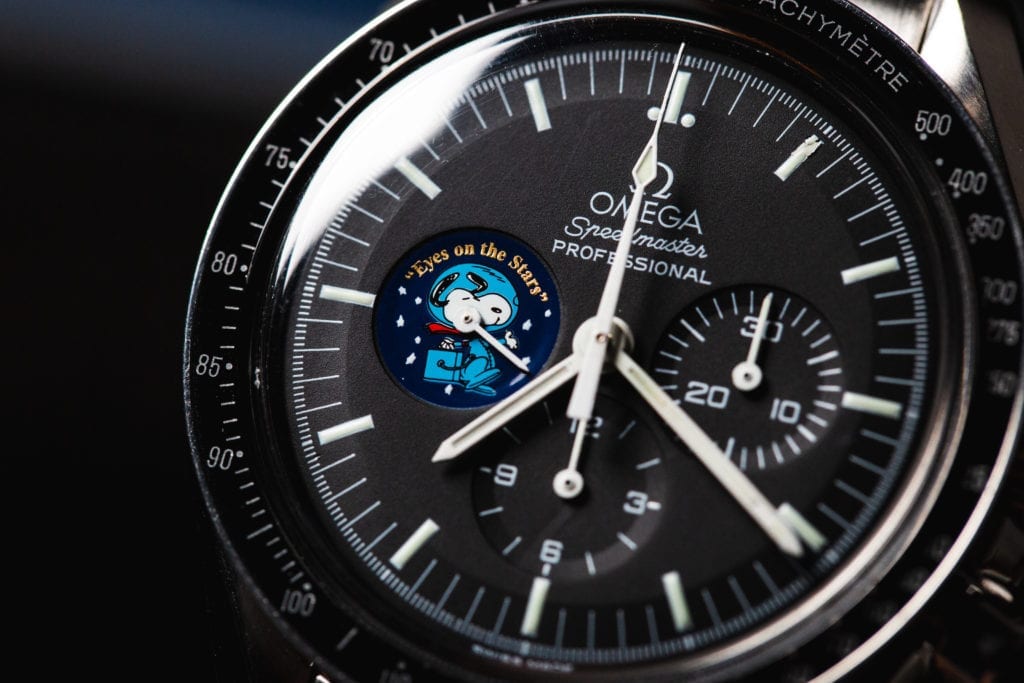
OMEGA Snoopy Edition Watches
Thirty-three years after the Apollo 13 mission, OMEGA introduced the first of their Snoopy Edition watches. As the name suggests, these models celebrate the Silver Snoopy Award NASA presented to the brand. The original edition, the Speedmaster Professional Snoopy Award, debuted in 2003 in a limited run of 5,441 pieces as a nod to the length of the mission: 142 hours, 54 minutes, and 41 seconds. The second came twelve years later in 2015. They only produced the Speedmaster Apollo 13 Silver Snoopy Award in a limited run of 1,970 pieces.
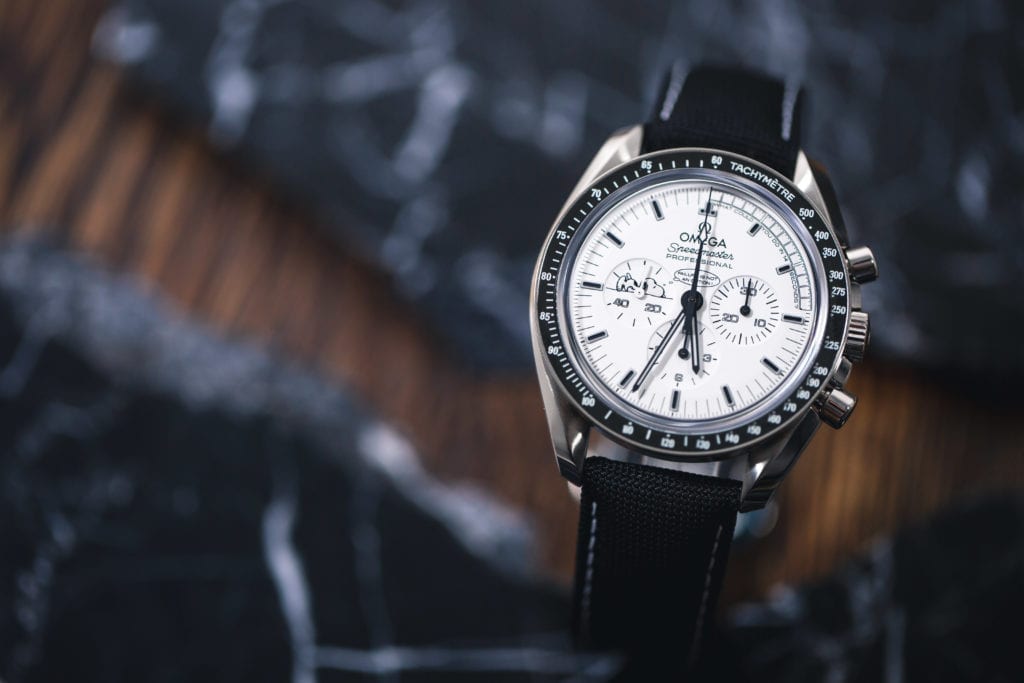
The Speedmaster Professional Snoopy Award Watch
The OMEGA Speedmaster Snoopy features a black luminova dial with a Snoopy badge painted on the subdial at the nine-o’clock position. It also comes equipped with a stainless steel case. On the caseback, there’s a colored variation of the Silver Snoopy Award logo. In addition, the OMEGA Speedmaster Snoopy features the words, “Eyes on the Stars.” The model has since been nicknamed the “Snoopy Eyes on the Stars” because of its incorporation of the NASA slogan.
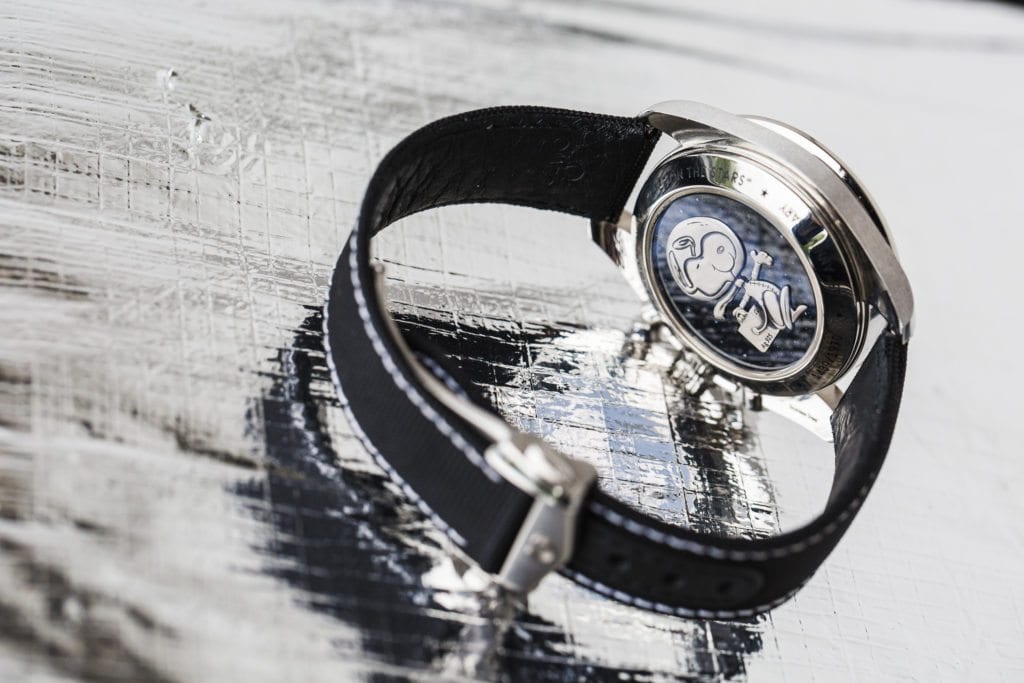
The Speedmaster Apollo 13 Silver Snoopy Award Watch
The Speedmaster Apollo 13 Silver Snoopy Award features a different design from the original OMEGA Snoopy watch and other Speedmasters. It showcases a white dial with a special fourteen-seconds counter. Along the counter of the OMEGA Apollo 13, there’s text that reads, “What could you do in 14 seconds?” The message is a reference to the critical window the crew had to burn the engines on the Apollo 13 mission. Like the initial OMEGA Snoopy watch, the 2015 version features Snoopy in the subdial at the nine-o’clock position. However, it’s a different rendering of the beloved character. Extending from the character, you’ll find a text bubble reading, “Failure is not an option.” Another notable feature of the watch is the luminescence of the dial. The tachymeter scale, indices, hands, and Snoopy himself all glow in the dark. Instead of the bracelet strap found on the original Snoopy and most Speedys, OMEGA Apollo 13 features a nylon strap. Finally, the caseback of the Silver Snoopy simply showcases the Award logo mounted on a dark blue enamel.
Get More Articles Like This in Your Inbox
We're constantly creating great content like this. So, why not get it delivered directly to your inbox? By subscribing you agree to our Privacy Policy but you can unsubscribe at any time.





